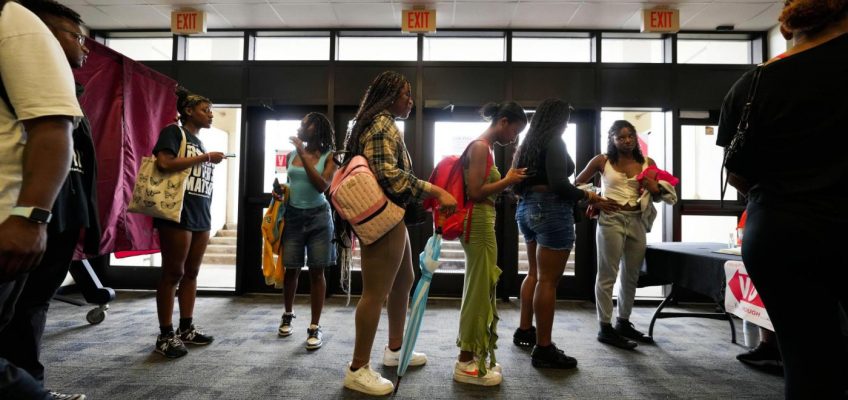By GARY FIELDS, Associated Press
WASHINGTON (AP) — Voting rights activists were relieved in 2023 when, in a surprise to some, the Supreme Court upheld the most important remaining element of the Voting Rights Act.
The ruling forced Alabama and later Louisiana to redraw their congressional maps to give Black residents greater representation, moves that eventually sent two additional Black lawmakers to Washington.
Two years later, the Voting Rights Act’s Section 2 is before the court again. This time, it’s a rehearing of a Louisiana lawsuit over the state’s redrawn congressional map in a case that revolves around the same part of the 60-year-old law.
At the heart of Wednesday’s arguments lies a simple question, and one with potentially far-reaching consequences: Will the court, with the same lineup of justices who decided the 2023 case, change its mind about the landmark law?
What is Section 2 of the Voting Rights Act?
Section 2 is the primary way plaintiffs can challenge racially discriminatory election practices. For nearly 50 years, a companion part of the law, Section 5, required certain states and counties with a history of discriminatory voting practices to get federal review before changing their election rules. Most of those places were in the South.
In 2013, the Supreme Court issued a 5-4 decision in a case known as Shelby v. Holder that removed the preclearance requirement in the Civil Rights-era law. States that had been under its jurisdiction began announcing changes to their election and voting laws, most of them restrictive.
That accelerated in Republican-controlled states after President Donald Trump began lying about his loss in the 2020 election, falsely claiming it was due to widespread fraud.
A decision against Section 2 would largely neuter the Voting Rights Act, said Binny Miller, a law professor at the American University.
“When Section 5 existed, it caught a lot of the problems that would have turned into Section 2 litigation,” he said.
Without those two pillars of the law, plaintiffs would have a much harder time challenging new voting restrictions. Instead, they would have to prove that lawmakers intended to discriminate.
More Black representation in Congress
Louisiana’s Republican-dominated Legislature drew a new congressional map in 2022 to account for population shifts reflected in the 2020 census. But the changes effectively maintained the status quo of five Republican-leaning majority white districts and one Democratic-leaning majority Black district in a state where the population is about one-third Black.
After civil rights advocates challenged the map, a district judge and then a federal appeals court panel agreed that the original map had likely violated Section 2.
The Supreme Court put that ruling on hold while it took up a similar case out of Alabama. The court’s 2023 ruling in favor of a second Black district there led to the election of Rep. Shomari Figures.
After that ruling, Republican Louisiana Gov. Jeff Landry urged the Legislature to revamp the state’s congressional map and create a new majority minority district that would give Black residents a greater chance of electing a representative of their choice. His other goal was to maintain safe Republican districts, including those of House Speaker Mike Johnson and House Majority Leader Steve Scalise.
The new 6th Congressional District, represented by Democratic Rep. Cleo Fields, stretches more than 200 miles (320 kilometers), linking parts of the Shreveport, Alexandria, Lafayette and Baton Rouge areas.
FILE – Democrat State Sen. Cleo Fields speaks during the swearing in of the Louisiana state legislature in Baton Rouge, La., Jan. 8, 2024. (AP Photo/Gerald Herbert, Pool, File)
Lawsuit from white plaintiffs challenges the new district
A different set of plaintiffs, a group of self-described “non-African Americans,” in January 2024 filed a lawsuit that claimed the new map that led to Fields’ election was illegal because it was driven too much by race, in violation of the Constitution.
In court filings, those plaintiffs have argued that the basis for the new district is racial and does not follow the standards for drawing a district, including compactness: “The State has not even tried to cover its motives or offer race-neutral reasons for the map,” one court filing said.
The Supreme Court heard the case in March but reached no decision in that term. In an unusual move, it instead ordered a new briefing on the case, leading to Wednesday’s arguments.
Why is the case being argued again?
The court has asked the parties to answer the question of: “Whether the state’s intentional creation of a second majority-minority congressional district violates the Fourteenth or Fifteenth Amendments to the U.S. Constitution.”
Those amendments, adopted in the aftermath of the Civil War, were intended to bring about political equality for Black Americans.
Justice Clarence Thomas signaled at least one point of view in his dissent against not addressing the case in the last session, arguing that the court’s interpretation of Section 2 is in direct conflict with the equal protection clause of the 14th Amendment to the Constitution.
“The Constitution is supreme over statutes and no intervening developments will change that,” he argued.
In the run-up to the new hearing, Louisiana abandoned its defense of the map it had drawn and urged the Supreme Court to reject any consideration of race in redistricting.
There is a range of possible outcomes. The court could send the case back to a lower court with instructions to draw a new map, including reexamining some of those presented by the original plaintiffs. On the extreme, the court could say that Section 2 and its reliance on racial considerations is out of line with the 14th and 15th amendments.
FILE – The Supreme Court in Washington, June 30, 2024. (AP Photo/Susan Walsh, File)
How could undercutting Section 2 affect future elections?
The new Alabama district created after the 2023 Supreme Court decision would almost certainly be drawn out of existence, along with the Louisiana seat now held by Fields. All other congressional districts that have resulted from Section 2 cases also would be in jeopardy.
It doesn’t stop there.
The role of Section 2 is often discussed in relation to Congress. But about three-quarters of all Section 2 lawsuits pertain to state and local government bodies, said Kareem Crayton, senior director for voting and representation at the Brennan Center for Justice at New York University.
City councils, county commissions, school boards and other local elected offices “have been the direct recipients” of plaintiffs bringing those cases, he said.
Federal workers endure financial strain and fear layoffs as the government shutdown drags on
The government shutdown is putting a renewed spotlight on the cracks in the US aviation system
Watch: Supreme Court takes up GOP-led challenge to Voting Rights Act that could affect control of Congress
Social Security cost-of-living increase announcement delayed by government shutdown
Meta removes ICE-tracking Facebook page in Chicago at the request of the Justice Department
A significant ruling that dilutes that part of the Voting Rights Act also would likely negate another voting rights case coming to the court. That one involves two North Dakota Native American tribes that have sued to overturn a legislative map they say does not give them representation.
A panel of the 8th U.S. Circuit Court of Appeals ruled against the tribes and in doing so overturned decades of precedent. It said private individuals and organizations cannot bring voting rights challenges. The judges said that right was reserved for the U.S. Justice Department, even though it’s responsible for filing only a fraction of those types of cases.
That case would seem to be moot if the Supreme Court undercuts Section 2 in the Louisiana case, especially if it all but prohibits challenges to voting or election laws thought to be racially discriminatory.




